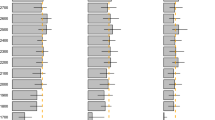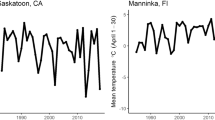Abstract
The most commonly reported ecological effects of climate change are shifts in phenologies, in particular of warmer spring temperatures leading to earlier timing of key events1,2. Among animals, however, these reports have been heavily biased towards avian phenologies, whereas we still know comparatively little about other seasonal adaptations, such as mammalian hibernation. Here we show a significant delay (0.47 days per year, over a 20-year period) in the hibernation emergence date of adult females in a wild population of Columbian ground squirrels in Alberta, Canada. This finding was related to the climatic conditions at our study location: owing to within-individual phenotypic plasticity, females emerged later during years of lower spring temperature and delayed snowmelt. Although there has not been a significant annual trend in spring temperature, the date of snowmelt has become progressively later owing to an increasing prevalence of late-season snowstorms. Importantly, years of later emergence were also associated with decreased individual fitness. There has consequently been a decline in mean fitness (that is, population growth rate) across the past two decades. Our results show that plastic responses to climate change may be driven by climatic trends other than increasing temperature, and may be associated with declines in individual fitness and, hence, population viability.
This is a preview of subscription content, access via your institution
Access options
Subscribe to this journal
Receive 51 print issues and online access
$199.00 per year
only $3.90 per issue
Buy this article
- Purchase on Springer Link
- Instant access to full article PDF
Prices may be subject to local taxes which are calculated during checkout


Similar content being viewed by others
References
Parmesan, C. Ecological and evolutionary responses to recent climate change. Annu. Rev. Ecol. Evol. Syst. 37, 637–669 (2006)
Thackeray, S. J. et al. Trophic level asynchrony in rates of phenological change for marine, freshwater and terrestrial environments. Glob. Change Biol. 16, 3304–3313 (2010)
Both, C., van Asch, M., Bijlsma, R. G., van den Burg, A. B. & Visser, M. E. Climate change and unequal phenoloical changes across four trophic levels: constraints or adaptations? J. Anim. Ecol. 78, 73–83 (2009)
Intergovernmental Panel on Climate Change. The Physical Science Basis: Contribution of Working Group I to the Fourth Assessment Report of the Intergovernmental Panel on Climate Change (Cambridge Univ. Press, 2007)
Visser, M. E. Keeping up with a warming world: assessing the rate of adaptation to climate change. Proc. R. Soc. B. 275, 649–659 (2008)
Ozgul, A. et al. Coupled dynamics of body mass and population growth in response to environmental change. Nature 466, 482–485 (2010)
Parmesan, C. & Yohe, G. A globally coherent fingerprint of climate change impacts across natural systems. Nature 421, 37–42 (2003)
Root, T. L. et al. Fingerprints of global warming on wild animals and plants. Nature 421, 57–60 (2003)
Møller, A. P., Rubolini, D. & Lehikoinen, E. Populations of migratory bird species that did not show a phenological response to climate change are declining. Proc. Natl Acad. Sci. USA 105, 16195–16200 (2008)
Both, C., Bouwhuis, S., Lessells, C. M. & Visser, M. E. Climate change and population declines in a long-distance migratory bird. Nature 441, 81–83 (2006)
Saino, N. et al. Climate warming, ecological mismatch at arrival and population decline in migratory birds. Proc. R. Soc. B. 278, 835–842 (2011)
Geiser, F. & Ruf, T. Hibernation versus daily torpor in mammals and birds: physiological variables and classification of torpor patterns. Physiol. Zool. 68, 935–966 (1995)
Humphries, M. M., Thomas, D. W. & Kramer, D. L. The role of energy availability in mammalian hibernation: a cost-benefit approach. Physiol. Biochem. Zool. 76, 165–179 (2003)
Michener, G. R. Spring emergence schedules and vernal behaviour of Richardson’s ground squirrels: why do males emerge from hibernation before females? Behav. Ecol. Sociobiol. 14, 29–38 (1983)
Dobson, F. S., Badry, M. J. & Geddes, C. Seasonal activity and body mass of Columbian ground squirrels. Can. J. Zool. 70, 1364–1368 (1992)
Michener, G. R. Effects of climatic conditions on the annual activity and hibernation cycle of Richardson’s ground squirrels and Columbian ground squirrels. Can. J. Zool. 55, 693–703 (1977)
Lane, J. E. et al. A quantitative genetic analysis of hibernation emergence date in a wild population of Columbian ground squirrels. J. Evol. Biol. 24, 1949–1959 (2011)
Nussey, D. H., Wilson, A. J. & Brommer, J. E. The evolutionary ecology of individual phenotypic plasticity in wild populations. J. Evol. Biol. 20, 831–844 (2007)
Christensen, J. H. et al. in The Physical Science Basis. Contribution of Working Group I to the Fourth Assessment Report of the Intergovernmental Panel on Climate Change (eds Solomon, S. et al.) 847–940 (Cambridge Univ. Press, 2007)
Murie, J. O. & Harris, M. A. Annual variation of spring emergence and breeding in Columbian ground squirrels (Spermophilus columbianus). J. Mamm. 63, 431–439 (1982)
Qvarnström, A. Brommer, J. E. & Gustafsson, L. Testing the genetics underlying the co-evolution of mate choice and ornament in the wild. Nature 441, 84–86 (2006)
Wiggett, D. R. & Boag, D. A. Intercolony natal dispersal in the Columbian ground squirrel. Can. J. Zool. 67, 42–50 (1989)
Murie, J. O., Boag, D. A. & Kivett, V. K. Litter size in Columbian ground squirrels (Spermophilus columbianus). J. Mamm. 61, 237–244 (1980)
Dobson, F. S. & Murie, J. O. Interpretation of intraspecific life history patterns: evidence from Columbian ground squirrels. Am. Nat. 129, 382–397 (1987)
Boag, D. A. & Murie, J. O. Weight in relation to sex, age and season in Columbian ground squirrels (Sciuridae: Rodentia). Can. J. Zool. 59, 999–1004 (1981)
Charmantier, A. et al. Adaptive phenotypic plasticity in response to climate change in a wild bird population. Science 320, 800–803 (2008)
van de Pol, M. & Wright, J. A simple method for distinguishing within- versus between-subject effects using mixed models. Anim. Behav. 77, 753–758 (2009)
Lande, R. & Arnold, S. J. The measurement of selection on correlated characters. Evolution 37, 1210–1226 (1983)
Whiteman, C. D. Mountain Meteorology: Fundamentals and Applications. (Oxford University Press, 2000)
Bates, D. M., Maechler, M. & Dai, B. lme4: Linear mixed-effects models using S4 classes. http://r-forge.r-project.org/ (2008)
Sæther, B.-E., Ringsby, T. H., Bakke, O. & Solberg, E. J. Spatial and temporal variation in demography of a house sparrow metapopulation. J. Anim. Ecol. 68, 628–637 (1999)
Acknowledgements
We thank the volunteers and assistants who helped with fieldwork, and the University of Calgary for providing accommodation at the Biogeosciences Institute (E. Johnson and J. Buchanan-Mappin). D. Stralberg, S. Boutin and E. Bayne provided comments and assistance that improved an earlier version of this paper, and M. Low wrote the R script to calculate the spring temperature climate window. Funding was provided by the Natural Sciences and Engineering Research Council of Canada (NSERC) (J.O.M. and S. Boutin (University of Alberta)), National Science Foundation (DEB-0089473) (F.S.D.), the Royal Society of London (J.E.L. and L.E.B.K) and Agence Nationale de la Recherche of France (ANR-08-JCJC-0041-01) (A.C., F.S.D. and J.E.L.) and the Alberta Conservation Association (J.E.L.). All protocols were approved by the Life and Environmental Sciences Animal Care Committee at the University of Calgary as well as the Animal Care and Use Committee at the University of Alberta (1992 to 1998) or the Institutional Animal Care and Use Committee at Auburn University (1999 to 2011).
Author information
Authors and Affiliations
Contributions
J.E.L., L.E.B.K., A.C. and F.S.D. developed the concept of the paper, and F.S.D. and J.O.M. collected the field data. J.E.L. performed all analyses and wrote the paper, and all other authors provided intellectual insight and detailed comments. All authors obtained funding.
Corresponding author
Ethics declarations
Competing interests
The authors declare no competing financial interests.
Supplementary information
Supplementary Information
This file contains Supplementary Text, Supplementary Figures 1 and 2, Supplementary Tables 1-3 and additional references. (PDF 438 kb)
PowerPoint slides
Rights and permissions
About this article
Cite this article
Lane, J., Kruuk, L., Charmantier, A. et al. Delayed phenology and reduced fitness associated with climate change in a wild hibernator. Nature 489, 554–557 (2012). https://doi.org/10.1038/nature11335
Received:
Accepted:
Published:
Issue Date:
DOI: https://doi.org/10.1038/nature11335
This article is cited by
-
Thinner bats to face hibernation as response to climate warming
Scientific Reports (2024)
-
Plants forage for soil patches free of plastic pollution but cannot bag the profits
Scientific Reports (2023)
-
Effects of temperature and precipitation changes on shifts in breeding phenology of an endangered toad
Scientific Reports (2023)
-
Primates facing climate crisis in a tropical forest hotspot will lose climatic suitable geographical range
Scientific Reports (2023)
-
The decline of the ecosystem services generated by anadromous fish in the Iberian Peninsula
Hydrobiologia (2023)
Comments
By submitting a comment you agree to abide by our Terms and Community Guidelines. If you find something abusive or that does not comply with our terms or guidelines please flag it as inappropriate.



